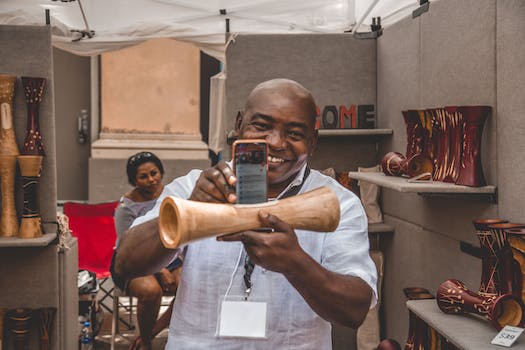How To Start A Business Selling Art
“Transform your passion for art into a profitable business with these essential tips.”
Introduction
Starting a business selling art can be a fulfilling and profitable venture for those with a passion for creativity and entrepreneurship. However, it can also be a challenging and competitive industry to break into. In this guide, we will provide some tips and steps to help you get started on your journey to becoming a successful art entrepreneur.
Finding Your Niche in the Art Market
Starting a business selling art can be a daunting task, but with the right approach, it can be a fulfilling and profitable venture. One of the first steps in starting a business selling art is finding your niche in the art market. This involves identifying the type of art you want to sell and the audience you want to target.
The art market is vast and diverse, with a wide range of styles, mediums, and genres. To find your niche, you need to do some research and explore different areas of the art market. Look at what is currently popular and what is in demand. Consider your own interests and passions, and think about the type of art that resonates with you.
Once you have identified your niche, you need to research your target audience. Who are the people that are most likely to buy your art? What are their interests and preferences? What is their budget? Understanding your target audience is crucial in developing a successful business strategy.
One way to find your niche in the art market is to attend art fairs and exhibitions. This will give you the opportunity to see what other artists are creating and what is currently popular. You can also network with other artists and art dealers, which can help you gain valuable insights into the art market.
Another way to find your niche is to create a portfolio of your work and showcase it online. This will allow you to reach a wider audience and get feedback on your art. You can also use social media to promote your work and connect with potential buyers.
When finding your niche in the art market, it is important to be authentic and true to your own style and vision. Don’t try to copy what is currently popular or create art that doesn’t resonate with you. Your passion and authenticity will shine through in your work and attract the right audience.
In addition to finding your niche, it is important to develop a strong brand identity for your business. This includes creating a logo, website, and social media presence that reflects your style and vision. Your brand identity should be consistent across all platforms and convey a clear message to your target audience.
Once you have found your niche and developed your brand identity, it is time to start selling your art. There are many ways to sell art, including online marketplaces, art galleries, and art fairs. Each option has its own advantages and disadvantages, so it is important to do your research and choose the best option for your business.
When selling your art, it is important to price it appropriately. This involves considering the cost of materials, the time and effort you put into creating the art, and the market demand for your work. Don’t undervalue your art, but also don’t overprice it and price yourself out of the market.
In conclusion, finding your niche in the art market is a crucial step in starting a business selling art. It involves identifying the type of art you want to sell and the audience you want to target. By doing your research, developing a strong brand identity, and pricing your art appropriately, you can create a successful and fulfilling business selling art.
Building Your Brand as an Artist

Starting a business selling art can be a daunting task, but it can also be incredibly rewarding. As an artist, you have a unique perspective and style that can set you apart from others in the industry. Building your brand as an artist is crucial to the success of your business. Here are some tips on how to build your brand as an artist and start your business selling art.
First, define your style. What makes your art unique? What sets you apart from other artists? Take some time to really think about your style and what makes it special. This will help you to create a brand that is authentic and true to who you are as an artist.
Next, create a portfolio of your work. This can be done online or in person. Make sure that your portfolio showcases your best work and highlights your unique style. Your portfolio should be a reflection of your brand and should be consistent with the message you want to convey.
Once you have your portfolio, it’s time to start promoting your work. Social media is a great way to get your art in front of a larger audience. Create social media accounts for your business and start sharing your work. Use hashtags to help people find your art and engage with your followers. You can also reach out to influencers in your industry and ask them to share your work with their followers.
Networking is also important when building your brand as an artist. Attend art shows and events in your area and connect with other artists and industry professionals. This can help you to build relationships and get your work in front of a larger audience.
Another way to build your brand as an artist is to create a website for your business. This can be a great way to showcase your work and provide information about your business. Your website should be easy to navigate and should reflect your brand. You can also use your website to sell your art directly to customers.
Finally, consider partnering with other businesses or organizations. This can help you to reach a larger audience and build your brand. Look for opportunities to collaborate with other artists, galleries, or even local businesses. This can help you to build relationships and get your work in front of a larger audience.
Building your brand as an artist takes time and effort, but it’s worth it in the end. By defining your style, creating a portfolio, promoting your work, networking, creating a website, and partnering with other businesses, you can build a successful business selling art. Remember to stay true to your brand and be consistent in your messaging. With hard work and dedication, you can turn your passion for art into a thriving business.
Creating a Business Plan for Your Art Business
Starting a business selling art can be a fulfilling and exciting venture. However, it is important to have a solid plan in place before diving in. Creating a business plan for your art business is crucial to its success. In this article, we will discuss the key elements of a business plan and how to create one for your art business.
The first step in creating a business plan is to define your business. What type of art will you be selling? Will you be selling original pieces or reproductions? Will you be selling online or in a physical location? These are all important questions to consider when defining your business.
Next, you will need to conduct market research. This involves researching your target audience, competitors, and industry trends. Who is your target audience? What are their buying habits? Who are your competitors and what are they doing well? What are the current trends in the art industry? Answering these questions will help you better understand your market and position your business for success.
Once you have defined your business and conducted market research, it is time to create a marketing plan. This plan should outline how you will reach your target audience and promote your art business. Will you be using social media, email marketing, or advertising? How will you differentiate yourself from your competitors? Your marketing plan should be tailored to your specific business and target audience.
Another important aspect of your business plan is your financial plan. This should include your startup costs, projected revenue, and expenses. How much money will you need to start your business? How much do you expect to make in revenue? What are your monthly expenses? Having a clear understanding of your finances will help you make informed decisions and ensure the financial success of your art business.
Finally, you will need to create an operational plan. This plan should outline how you will run your art business on a day-to-day basis. This includes things like inventory management, shipping and handling, and customer service. How will you manage your inventory? What shipping and handling methods will you use? How will you handle customer inquiries and complaints? Having a solid operational plan in place will help you run your business efficiently and effectively.
In conclusion, creating a business plan for your art business is crucial to its success. Defining your business, conducting market research, creating a marketing plan, developing a financial plan, and creating an operational plan are all key elements of a successful business plan. By taking the time to create a solid plan, you will position your art business for success and achieve your goals. Good luck!
Setting Up Your Online Storefront
Starting a business selling art can be a daunting task, but with the right tools and mindset, it can be a fulfilling and profitable venture. One of the most important aspects of starting an art business is setting up your online storefront. In today’s digital age, having an online presence is crucial for any business, and the art industry is no exception. Here are some tips on how to set up your online storefront for your art business.
Firstly, you need to choose a platform to host your online store. There are many options available, such as Etsy, Shopify, and Squarespace. Each platform has its own advantages and disadvantages, so it’s important to do your research and choose the one that best suits your needs. Consider factors such as pricing, ease of use, and customization options.
Once you’ve chosen a platform, it’s time to create your online store. This involves setting up your store’s layout, adding product listings, and customizing your store’s branding. It’s important to make your store visually appealing and easy to navigate. Use high-quality images of your artwork and write detailed descriptions of each piece. This will help potential customers make informed decisions about their purchases.
Another important aspect of setting up your online storefront is pricing your artwork. It’s important to price your artwork fairly and competitively. Research the prices of similar artwork and consider factors such as the time and materials it took to create each piece. Don’t undervalue your work, but also don’t overprice it. Finding the right balance is key.
In addition to pricing, you should also consider shipping and handling costs. Make sure to factor in the cost of packaging materials and shipping fees when setting your prices. You can offer free shipping or flat-rate shipping to make the purchasing process easier for your customers.
Once your online store is set up, it’s important to promote it. Use social media platforms such as Instagram and Facebook to showcase your artwork and drive traffic to your online store. You can also consider running ads on these platforms to reach a wider audience. Networking with other artists and art enthusiasts can also help you gain exposure and attract potential customers.
Finally, it’s important to provide excellent customer service. Respond promptly to customer inquiries and address any issues or concerns they may have. This will help build trust and loyalty with your customers, which can lead to repeat business and positive reviews.
In conclusion, setting up your online storefront is a crucial step in starting a business selling art. Choose a platform that best suits your needs, create a visually appealing store, price your artwork fairly, promote your store through social media and networking, and provide excellent customer service. With these tips, you’ll be on your way to building a successful art business.
Marketing and Promoting Your Art Business
Starting a business selling art can be a daunting task, but with the right marketing and promotion strategies, it can be a successful venture. In this article, we will discuss some tips on how to effectively market and promote your art business.
Firstly, it is important to identify your target audience. Who are the people that would be interested in purchasing your art? Are they art collectors, interior designers, or everyday consumers? Once you have identified your target audience, you can tailor your marketing efforts to reach them.
One effective way to market your art business is through social media. Platforms such as Instagram, Facebook, and Pinterest are great for showcasing your artwork and reaching a wider audience. Make sure to post high-quality images of your art and use relevant hashtags to increase visibility. Engage with your followers by responding to comments and messages, and consider running social media ads to reach even more potential customers.
Another way to promote your art business is by attending art fairs and exhibitions. These events provide a great opportunity to showcase your artwork and network with other artists and potential buyers. Make sure to have business cards and promotional materials on hand, and consider offering special discounts or promotions to those who visit your booth.
Networking is also important in the art world. Attend local art events and join art organizations to meet other artists and potential buyers. Collaborate with other artists on projects or exhibitions to expand your reach and gain exposure.
In addition to social media and networking, consider creating a website for your art business. This will provide a platform for potential customers to view and purchase your artwork online. Make sure to include high-quality images of your art, a detailed description of each piece, and pricing information. You can also include a blog to share your artistic process and connect with your audience on a more personal level.
Email marketing is another effective way to promote your art business. Collect email addresses from customers and potential buyers, and send out regular newsletters with updates on your latest artwork, upcoming events, and special promotions. Make sure to include a call-to-action in each email, such as a link to purchase your artwork or attend an upcoming event.
Lastly, don’t underestimate the power of word-of-mouth marketing. Encourage satisfied customers to share their experience with others and offer incentives for referrals. Consider hosting a customer appreciation event or offering a loyalty program to reward repeat customers.
In conclusion, marketing and promoting your art business requires a combination of strategies tailored to your target audience. Utilize social media, attend art fairs and exhibitions, network with other artists, create a website, use email marketing, and encourage word-of-mouth referrals. With dedication and persistence, your art business can thrive.
Conclusion
Starting a business selling art requires careful planning and research. It is important to identify your target market, create a unique brand, and establish a strong online presence. Building relationships with customers and networking with other artists can also help to grow your business. With dedication and hard work, selling art can be a rewarding and profitable venture.





